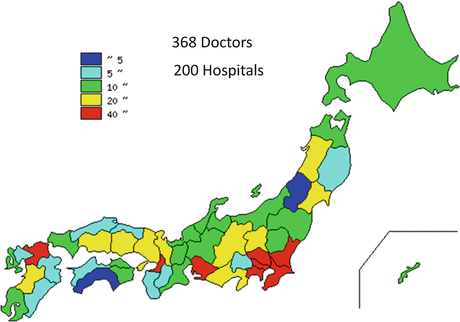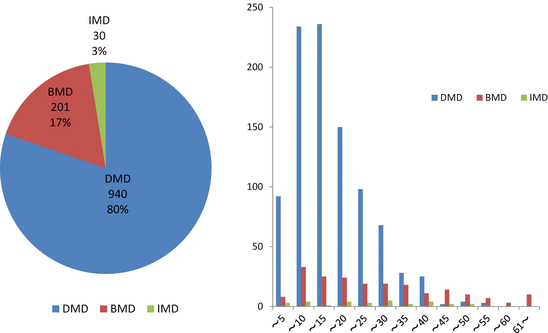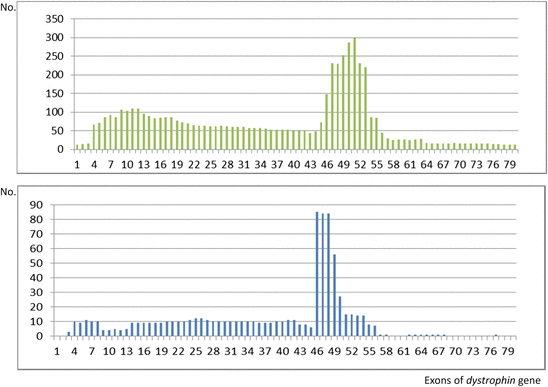Fig. 11.1
Number of registrants in Remudy national dystrophinopathy registry. As of May 2014, 1,293 patients were registered in this national registry from all over Japan. Blue bars show monthly registered number; red bars show total number accumulated since the start of the registry. Total number of registrants is still increasing

Fig. 11.2
Prefectural distribution of registrants in Remudy national dystrophinopathy registry. Dystrophinopathy patients from every prefecture in Japan are registered in this registry by cooperation of 368 doctors in 200 hospitals. Most registrants were concentrated in populated area: Fukuoka, Osaka, Aichi, and Kanto region

Fig. 11.3
Diagnosis and age distribution of registered individuals. Data from 1,171 patients who have agreed to participate in this study and confirmed by molecular and clinical curators were analyzed. It comprises of 940 (80 %) DMD, 201 (17 %) BMD, and 30 (3 %) IMD patients, respectively. Most registrants are under 20 years of age, but those over 35 years with DMD are also registered
Table 11.1
Distribution of mutation in the registrants with DMD and BMD
DMD | BMD | IMD | ||||
|---|---|---|---|---|---|---|
Number | % | Number | % | Number | % | |
Distribution of mutation | ||||||
Deletion | 388 | 60.6 | 90 | 76.9 | 8 | 47.1 |
Duplication | 87 | 13.6 | 6 | 5.1 | 5 | 29.4 |
Othersa | 163 | 24.3 | 19 | 16.2 | 4 | 23.5 |
Deletion and duplication | 1 | 0.2 | 0 | 0.0 | 0 | 0.0 |
No mutation foundb | 1 | 0.2 | 2 | 1.7 | 0 | 0.0 |
640 | 100 | 117 | 100 | 17 | 100 | |
Table 11.2
Clinical manifestations of Japanese dystrophinopathy patients in Remudy database
DMD | BMD | IMD | ||||
|---|---|---|---|---|---|---|
Number | % | Number | % | Number | % | |
Walking capacity | ||||||
Normal walking | 328 | 40.2 | 125 | 74.4 | 7 | 26.9 |
Not able to walk and sit without support | 252 | 30.9 | 38 | 22.6 | 10 | 38.5 |
Not able to sit without support | 229 | 28.1 | 5 | 3.0 | 9 | 34.6 |
Before development | 6 | 0.7 | 0 | 0.0 | 0 | 0.0 |
Cardiac function | ||||||
Normal | 516 | 63.3 | 120 | 71.4 | 13 | 50.0 |
Dysfunction | 277 | 34.0 | 47 | 28.0 | 13 | 50.0 |
Not performed | 22 | 2.7 | 1 | 0.6 | 0 | 0.0 |
Respiratory function | ||||||
Normal | 619 | 76.0 | 163 | 97.0 | 17 | 65.0 |
Dysfunction | 162 | 20.0 | 3 | 2.0 | 6 | 23.0 |
Not performed | 34 | 4.0 | 2 | 1.0 | 3 | 11.0 |
Steroid use | ||||||
Current | 264 | 32.4 | 8 | 4.8 | 6 | 23.1 |
Used to | 103 | 12.6 | 6 | 3.6 | 3 | 11.5 |
Never | 447 | 54.8 | 154 | 91.7 | 17 | 65.4 |
Total | 815 | 100 | 168 | 100 | 26 | 100 |

Fig. 11.4
Frequency of individual exon deletions. The distribution of exon deletion shows common hot spot regions in exon 45–54 in DMD and BMD
Remudy already supplied the epidemiological data for 11 feasibility studies, and provided timely information about two independent clinical trials to registrants who might be eligible for upcoming clinical trials, and accelerated the effective recruitment of eligible patients as expected. To inform the public of the activity of Remudy, we sent a paper version of “Remudy news,” “Remudy news letter” by e-mail, and frequently renewed news page on Remudy website. Remudy news volume 11 was published with 1,781 copies in June 2014, Remudy news letter volume 50 was sent out to 648 subscribers, and the Remudy website traffic count was 1,845 during June 2014. We also hosted local lecture meetings for medical experts and patients all over Japan. In 2013, we sent out the questionnaires for medical providers throughout Japan in 2013 to clarify how Remudy was well known. We found nearly 75 % of medical providers knew about the Remudy activity.
Stay updated, free articles. Join our Telegram channel

Full access? Get Clinical Tree







